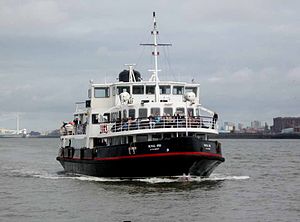MV Royal Iris of the Mersey
 |
|
| History | |
|---|---|
| Name: |
|
| Owner: | Merseytravel |
| Operator: |
|
| Port of registry: | 1959 onwards: Liverpool, |
| Route: | River Mersey Ferry |
| Ordered: | November 1957 |
| Builder: | Philip and Son, Dartmouth |
| Laid down: | 20 October 1958 |
| Launched: | 6 July 1959 |
| Christened: | 6 July 1959 |
| Maiden voyage: | 1960, delivery voyage from Dartmouth to the River Mersey. |
| In service: | 1960 - present |
| Identification: |
|
| General characteristics | |
| Tonnage: | 611 GT |
| Length: | 46.32 m (152 ft 0 in) |
| Beam: | 12.2 m (40 ft 0 in) |
| Draught: | 2.46 m (8 ft 1 in) |
| Decks: | 4 lower saloon, main deck, promenade deck, bridge deck |
| Installed power: | 2 x Wärtsilä medium speed diesel engines. |
| Speed: | max 12 – 14 knots |
| Capacity: | 860 for general ferry operations, 360 for cruising. |
| Crew: | 6 – Captain, Mate, Engineer, Deck Hands x 2, Catering Assistant |
The MV Royal Iris of the Mersey is a Mersey Ferry in operation on the River Mersey, England. From launch in Devon in 1959 until a major refurbishment in 2001, she was named MV Mountwood.
The Mountwood was the slightly older sister ship of the MV Woodchurch. Both of the ferries were built for the Corporation of Birkenhead to replace the existing fleet of 1930s steamers. The designs of the two new vessels were loosely based on the ferries Leasowe and Egremont of the Wallasey Corporation, they were designed by the same company, Graham and Woolnough and were built at the same shipyard, Messrs. Philip and Sons Ltd. of Dartmouth. Mountwood was launched by Mrs Hugh Platt on the 6 July 1959 into the River Dart, and after being fitted out was delivered to the Mersey in 1960. She was named after an overspill post-war housing development of Birkenhead.
The Mountwood and her identical sister Woodchurch originally had bright orange funnels with a black base and black soot buffer. On the main deck, there was a forward, heated shelter and also a main saloon, aft of this was the toilets and machine space. Below was a saloon bar. On the top deck was a large open promenade and a forward shelter beneath the bridge, although this shelter was open beneath the bridge so it was often breezy and cold. They had a main central wheelhouse and two side cabs, and power came from two medium speed Crossley 8-cylinder diesel engines. Upon the bridge deck, in the wheelhouse, one would find the large brass helm, the hydraulic steering telemotor. a binnacle, and two conjoined Chadburn Synchrostep engine order telegraphs. These were linked to the other two identical telegraphs in the docking cabs so they moved in tandem. There was also whistle controls and lighting controls. In the docking cabs or navigation boxes was another binnacle, a whistle control, telegraphs and also various indicators for engine/speed etc. Originally all ferries had a simple ship to shore communicating radio, but did not have radar or sonar. The wheelhouses of the two ferries differed slightly due to different positioning of rudder angle indicators and engine RPM gauges in the bridge wings. The telegraphs were designed to give the captain direct control of the engines (although they could still be used in the traditional signal / response manner) and as such were marked with commands such as 'brake'and 'start'. They also had more speed settings ahead and astern. The original engines could reach full speed within 3 seconds once 'run' had been passed.
...
Wikipedia
